The Orange Pi 5 Ultra offers high performance and multiple interfaces and storage options, making it a strong alternative to the Raspberry Pi 5 for those wanting better performance at a reasonable price. Here are its pros and cons:
- High performance Hardware.
- M.2 M-KEY slot for NVMe SSD (PCIe 3.0 4Lane)
- Onboard eMMC Socket.
- Next generation Wi-Fi 6E Support.
- 2.5G Ethernet port.
- Headphone jack.
- OpenWrt support.
- x3 Camera Interfaces.
- HDMI Input / Output ports.
- Embedded NPU (up to 6TOPS).
- None
- Maybe you missed it? Orange Pi 4A
- Orange Pi 5 Ultra Review: A look at its specifications, key features, and pricing.
Part 1: Introducing the Orange Pi 5 Ultra
A new SBC featuring a few significant upgrades.
Introducing the latest and most advanced Orange Pi 5 Ultra single-board computer, which comes packed with an incredibly powerful Rockchip RK3588 8-core 64-bit processor designed to deliver exceptional performance. This impressive processor not only enhances computing capabilities but also ensures efficient multitasking and smooth operation for a variety of applications.
With its cutting-edge technology, the Orange Pi 5 Ultra is geared towards developers and enthusiasts seeking high-performance solutions for projects ranging from artificial intelligence to multimedia applications. It represents a significant leap forward in the world of single-board computers, offering an unparalleled combination of speed and efficiency. This cutting-edge model features four Cortex-A76 cores running at 2.4GHz and four Cortex-A55 cores at 1.8GHz, along with an independent NEON coprocessor for enhanced performance.
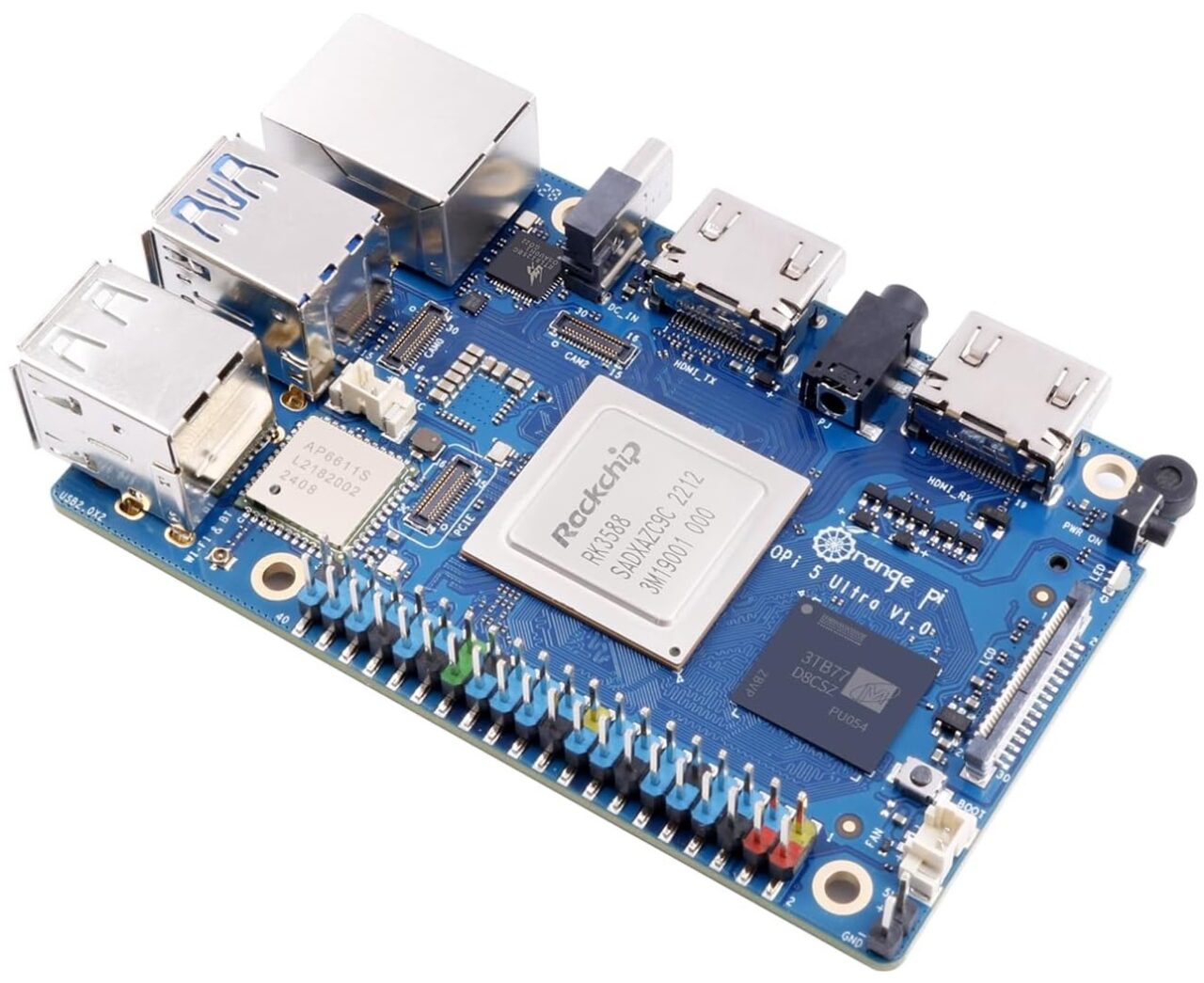
Featuring a 4K HDMI 2.0 Input – What advantages does having a 4K HDMI input provide?
Here are several practical applications:
- Home Media Center: Use it to stream and capture video from various devices to create a media hub. Connect gaming consoles, DVD players, or cameras to record and stream content.
- Surveillance System: Install security cameras and utilize the HDMI input to simultaneously view and record footage in real time. This approach is especially beneficial for closely monitoring multiple camera feeds at once.
- Digital Signage: Create engaging and interactive digital signage for businesses or events. With HDMI input capabilities, you can effortlessly stream content from various devices, ensuring a seamless and engaging display experience.
- Educational Tools: In a classroom environment, educators have the ability to link multiple video sources, like microscopes and document cameras, to the SBC, enabling the display of live demonstrations or recorded material for their students.
- Gaming Console: Transform your SBC into a retro gaming console by seamlessly connecting classic gaming systems via HDMI input. Capture and stream your gameplay sessions, or indulge in nostalgic gaming experiences on contemporary displays.
- Video Conferencing System: Enhance your SBC by integrating it with conferencing hardware to obtain high-quality video from external cameras, transforming it into an essential asset for remote meetings and presentations.
- Portable Presentation Device: Use it for presentations and meetings in corporate settings. Connect your laptop or other devices to the HDMI input to display content on a larger screen.
Specifications for the Orange Pi 5 Ultra.
| Master Chip | Rockchip RK3588 (8nm LP process) |
| CPU | • 8-core 64-bit processor • 4 Cortex-A76 and 4 Cortex-A55 with independent NEON coprocessor • Cortex-A76 at 2.4GHz, Cortex-A55 at 1.8GHz |
| GPU | • Integrated ARM Mali-G610 • Built-in 3D GPU • Fully compatible with OpenGL ES1.1/2.0/3.2, OpenCL 2.2 and Vulkan 1.2. |
| NPU | Embedded NPU supports INT4/INT8/INT16/FP16 hybrid computing with up to 6TOPS. |
| PMU | RK806-1 |
| RAM | LPDDR5 496PIN:4GB、8GB、16GB optional |
| Memory | • eMMC flash socket • eMMC IC Note: Either eMMC flash socket or eMMC IC, support: 32GB, 64GB, 128GB, 256GB optional • QSPI nor flash: 16MB • MicroSD card slot • M.2 M-KEY slot: support NVMe SSD (PCIe 3.0 4Lane) |
| USB | 2*USB3.0;2*USB2.0; |
| Video | • 1* HDMI 2.1 out up to 8k@60FPS • 1* HDMI 2.0 in up to 4k@60FPS • 1* MIPI DSI TX 4 Lane |
| Camera | • 2* MIPI CSI 4 Lane • 1* MIPI D-PHY RX 4 Lane |
| Audio | CODEC:ES8388 • 1* Audio 3.5mm jack with mic • 1*MIC • 1*HDMI 2.1 eARC |
| Ethernet | 1*PCIe 2.5G LAN(RTL8125BG ) |
| Wi-Fi+BT Module | Onboard Wi-Fi 6E+BT 5.3/BLE module: AP6611 Wi-Fi interface: SDIO3.0 BT interface: UART/PCM |
| Expansion Port | Dual-row pin: 2.54mm 40Pin Supports DC 5V and 3.3V power output. Configurable UART, PWM, I2C, SPI, CAN, GPIO and other functional interfaces. |
| Button | 1* MaskRom key, 1 * On/Off-key |
| Power Source | Supports Type-C power supply, 5V @ 5A |
| LED | RGB LED side illumination |
| FAN | 5V 2PIN 1.25mm socket |
| RTC | 3V 2PIN 1.25mm socket |
| Debugging | Debug serial UART included in 40PIN expansion port |
| Supported OS | OrangePi OS(Droid)、Orangepi OS(Arch)、Orangepi OS(OH)、Ubuntu、Debian、Android 13. |
| PCB | Length: 89mm, width: 57mm, thickness: 1.6mm |
| Weight | 60.5g |
The Design and Layout of the Board
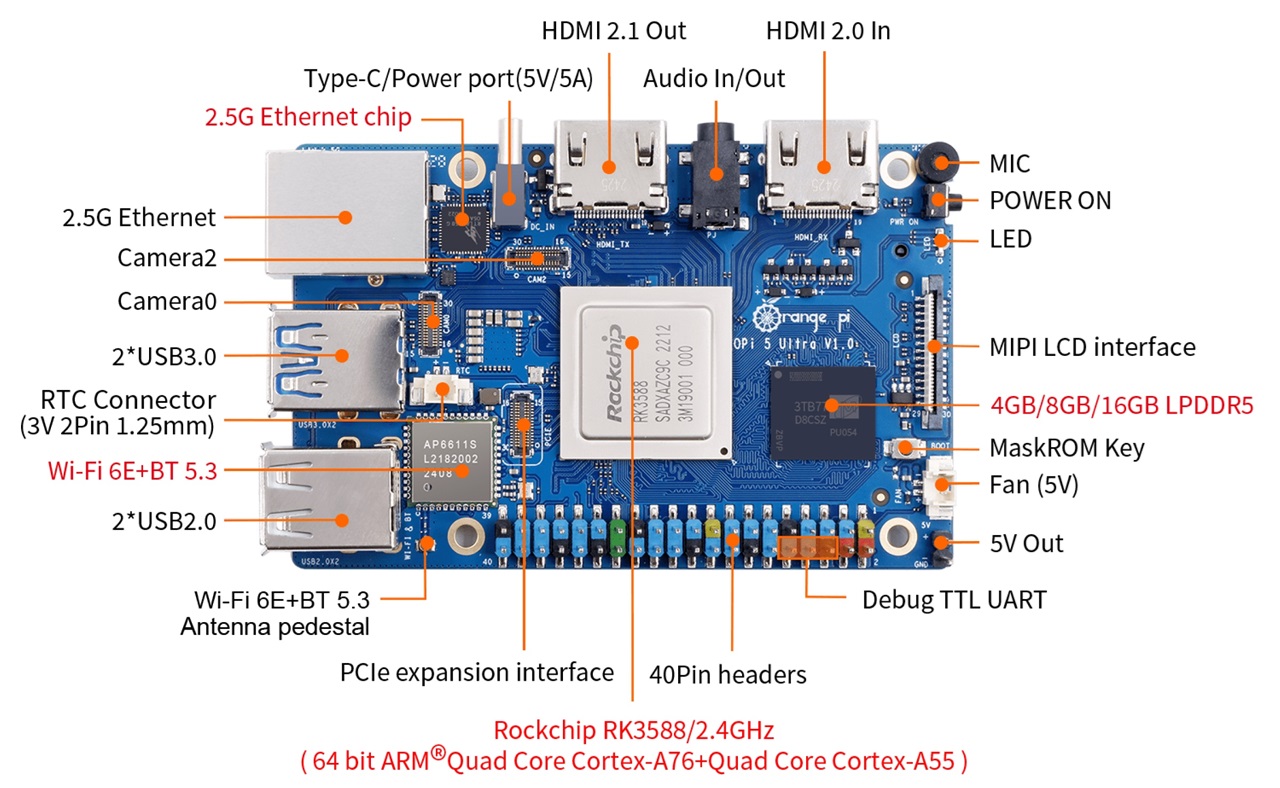
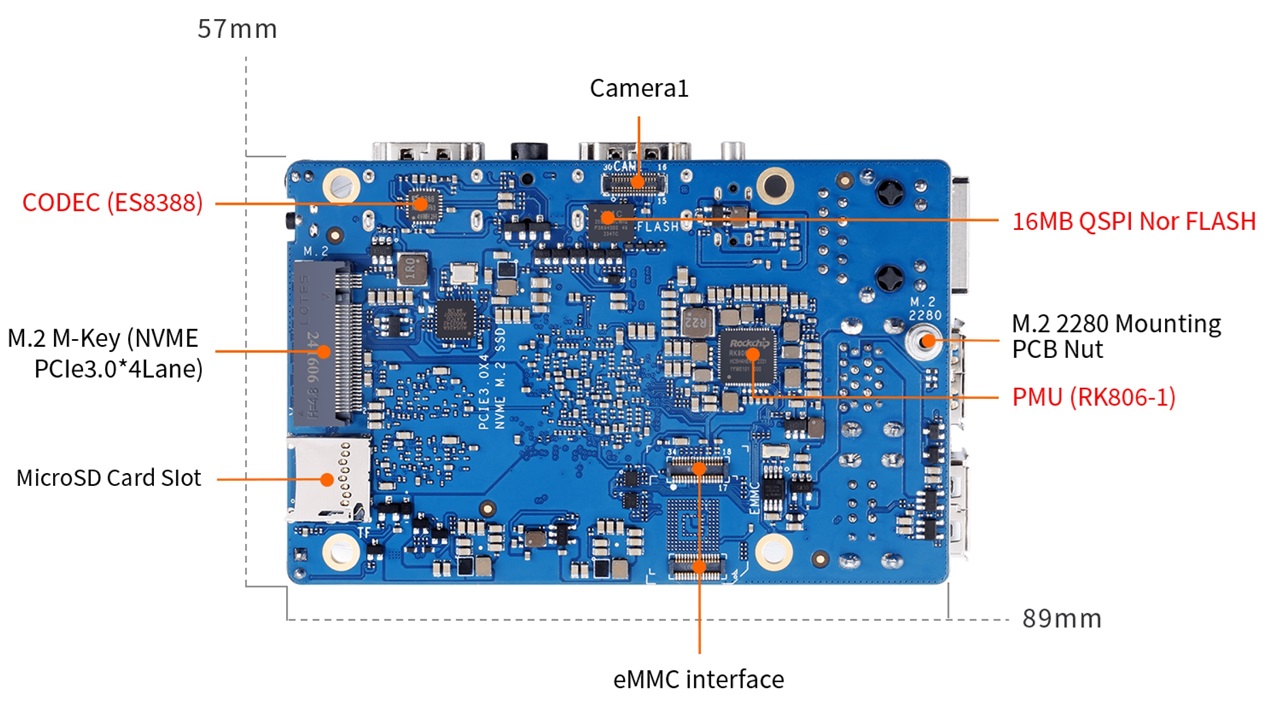
How does it compare to Orange Pi 5 Max model?
The Ultra 5 Model Comes Equipped with an HDMI Input port
While both boards offer comparable performance and features, the primary distinction is in their HDMI ports. The Orange Pi 5 Max is equipped with two 8K HDMI output ports, whereas the Orange Pi 5 Ultra features one port that supports up to 8K at 60FPS and another that accommodates 4K HDMI input, which makes the Ultra particularly suitable for DVR recording functionality.
Here’s a hardware comparison between the Orange Pi 5 Max and Orange Pi 5 Ultra:
| Feature | Orange Pi 5 Max | Orange Pi 5 Ultra |
|---|---|---|
| Rockchip RK3588 Processor | ✅ | ✅ |
| CPU 4 x Cortex-A76 @ 2.4 GHz 4 x Cortex-A55 @ 1.8 GHz | ✅ | ✅ |
| 6TOPS NPU | ✅ | ✅ |
| Graphics (ARM Mali-G610 MP4) | ✅ | ✅ |
| RAM (Up to 16GB LPDDR5) | ✅ | ✅ |
| Storage Options: eMMC module microSD card reader M.2 M-Key slot (PCIe 3.0 x4 NVMe or SATA SSD) | ✅ | ✅ |
| HDMI Ports | 1x HDMI 2.1, up to 8k@60FPS 1x HDMI 2.0 Input, up to 4k@60FPS | 1x HDMI 2.1, up to 8k@60FPS 1x HDMI 2.1, up to 8k@60FPS |
| Wi-Fi 6E | ✅ | ✅ |
| Bluetooth 5.3 | ✅ | ✅ |
| 2.5 GbE Ethernet (RTL8125BG) | ✅ | ✅ |
| USB Ports: 2x USB 3.0 Type-A 2x USB 2.0 Type-A | ✅ | ✅ |
| Camera Connectors (MIPI-CSI) | ✅ | ✅ |
| PCI expansion Interface | ✅ | ✅ |
| 3.5mm Audio | ✅ | ✅ |
| Power Input (USB Type-C (5V/5A) | ✅ | ✅ |
What are the new updates in this particular model?
While all Orange Pi 5 boards may initially look quite similar at first glance, upon closer inspection, you will find that there are always subtle yet significant changes and hardware enhancements integrated into them. These modifications can include variations in processing power, memory options, and connectivity features that can greatly affect performance and user experience.
Additionally, even minor tweaks in the design can result in improved efficiency or compatibility with certain applications. Therefore, it’s essential for users to pay attention to these details when selecting the right Orange Pi 5 board for their specific needs. The Pi 5 range is no exception to this trend! Here are the new features worth pointing out.
What’s New and Improved?
- Faster Memmory: LPDDR5 RAM outperforms its predecessor, LPDDR4, by offering enhanced speed and energy efficiency, making it ideal for high-performance applications and intricate 3D gaming. It accommodates a wide range of configurations, including 32GB, 64GB, 128GB, and 256GB.
- Upgraded Ethernet LAN port: The board has a 2.5 Gbps Ethernet port, boosting data transfer rates over standard connections. This upgrade facilitates improved network performance, making it ideal for demanding applications that require faster connectivity.
- Multiply video ports: 1 HDMI 2.1 output (8K at 60FPS), 1 HDMI 2.0 input (4K at 60FPS), DSI TX 4 Lane, and MIPI LCD interface.
- Intergated Wi-Fi 6E: The integration of Wi-Fi 6E technology onboard greatly improves wireless connectivity, making it exceptionally beneficial for streaming and file transfers.
- Supports three MIPI CSI camera interfaces, each with four lanes.
- Onboard eMMC flash socket: Available to expand your storage capacity.
- 16MB QSPI NOR Flash Memory.
- M.2 M-Key Socket: PCIe 3.0 x 4 Lane for NVMe Installation.
Orange Pi software support provides an extensive range of options compatible with all major Linux distributions, including Orangepi OS (Droid), Orangepi OS (Arch), Orangepi OS (OH), Ubuntu, and Debian. Additionally, the inclusion of Android 13 support is a significant advantage.
Software Support
The company offers a comprehensive selection of options that are compatible with all major Linux distributions, such as Orangepi OS (Droid), Orangepi OS (Arch), Orangepi OS (OH), Ubuntu, and Debian. Furthermore, the support for Android 13 adds considerable value to their offerings.
How does the new model compare to the Raspberry Pi 5?
The Orange Pi 5 Ultra is expected to be significantly faster, thanks to its octa-core CPU. Additionally, the Raspberry Pi 5 utilizes slower LPDDR4 memory, while the Orange Pi 5 Ultra boasts LPDDR5 memory, further enhancing its performance.
Here is a concise comparison of benchmark test results between the previous Orange Pi 5 Plus with LPDDR4X memory and the Raspberry Pi 5, which also utilizes LPDDR4X memory. The new ultra model is anticipated to yield higher results due to a wider and faster memory bandwidth.
| Benchmark Test | Orange Pi 5 Plus | Raspberry Pi 5 |
|---|---|---|
| Single-Core Score | 855 | 748 |
| Multi-Core Score | 3,050 | 1,507 |
| Geekbench 5 | Single-Core: 1,800 | Single-Core: 2,000 |
| Multi-Core: 7,500 | Multi-Core: 6,000 | |
| PassMark | 2,500 | 2,800 |
| AI Performance | ARM Mali-G610 MP4 | VideoCore VII |
| Power Consumption | 5W | 4W |

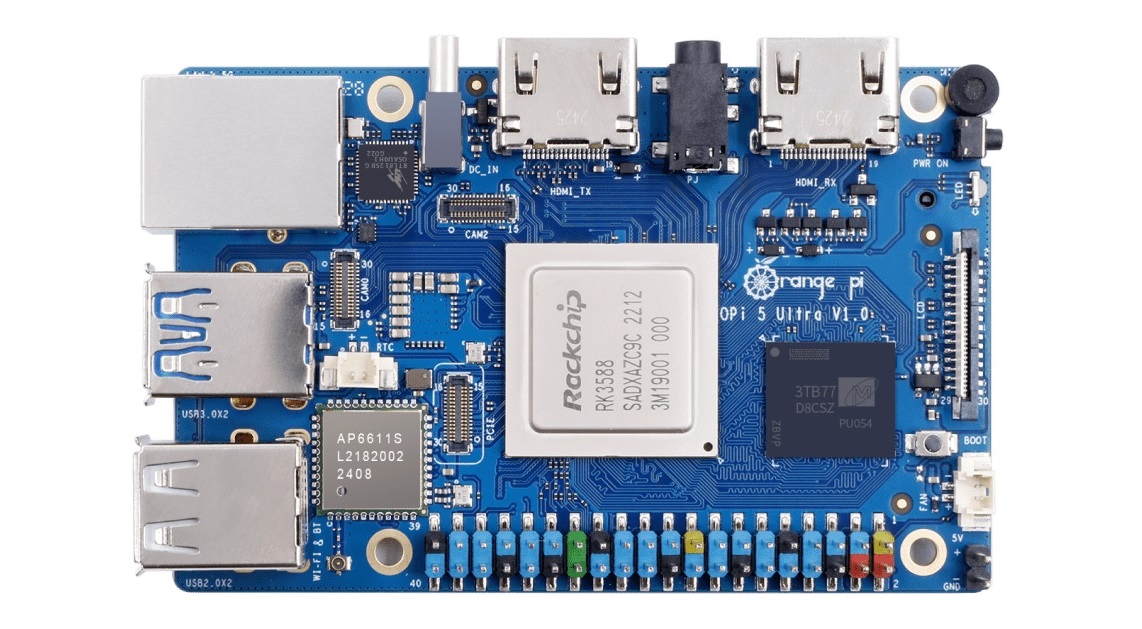
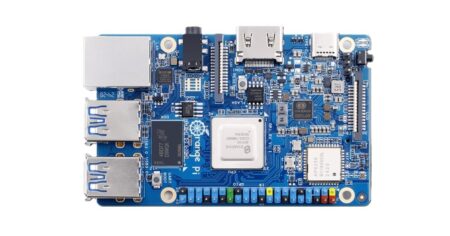


Orange Pi needs to stop this nonsense. ANOTHER board?? Nobody can keep up with software – Armbian isn’t even supporting the Max.
You don’t have to use Armbian, although it offers long-term support. The Orange Pi Ubuntu image works well, and I’m sure that a DietPi image will be available soon.
Well, there is a factory and employees, so people need continuous work all the time.